What is an Awl?
What is an awl and what is it used for? Learn why you want one, what could happen if you don’t use an awl, and how to use it in this step-by-step tutorial.
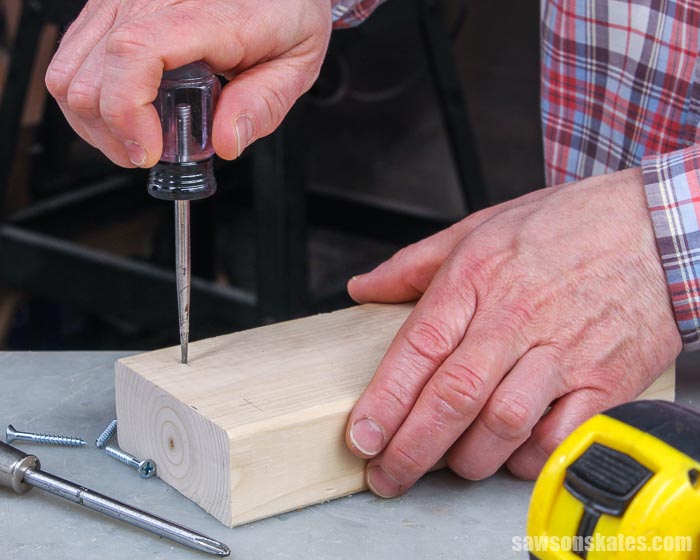
What is an Awl?
DIYers often ask “what is an awl?”, “what is an awl used for in woodworking?”, and “do you need an awl?”.
We’re answering all of these questions, plus, we’ll look at two ways to use an awl.
This tutorial contains affiliate links to supplies and tools. Purchases made using these links help support the Saws on Skates website and allows me to share more projects and tips with you. There is no cost to you for using these links. Visit my site policies for more information.
Before we get into using an awl, be sure to click the subscribe button at the bottom of this page to sign up for my FREE weekly newsletter loaded with helpful pocket hole tricks, space-saving workshop ideas, clever DIY tips and more!
Table of Contents
What is an Awl?
An awl is basically a metal shaft with a sharp point. Think of an awl like a nail attached to a handle.
There are several types of awls. A stitching awl is used on materials like leather and canvas. A scratch awl is used for woodworking. We’ll be focusing on the scratch awl for this tutorial.
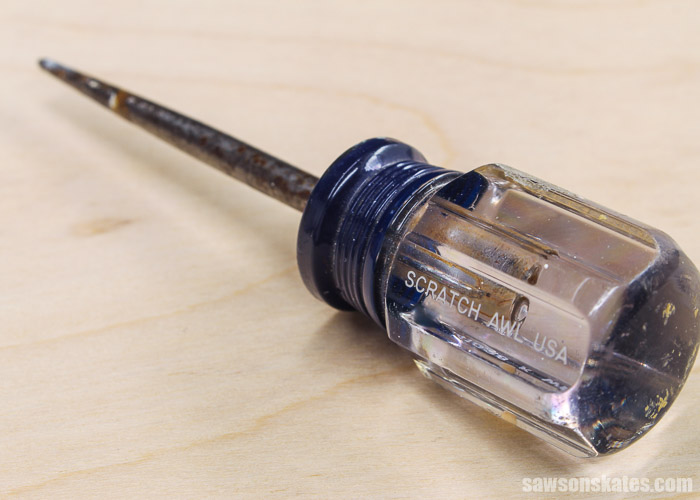
What is Awl Used for in Woodworking?
Merriam-Webster defines an awl as a “pointed tool for marking surfaces or piercing small holes.”
A scratch awl is often referred to as an awl. It’s used to create a starting point for another tool.
It can be used to scribe lines as a starting point for a hand saw or chisel. It can also be used to make holes as a starting point for a screw or drill bit.
Related: Impact Driver vs Drill: What’s the Difference?
Scribe Lines
An awl can be used to scribe lines to create a starting point for a hand saw or chisel.
Awls are typically used to scribe lines with the grain of the wood. It can be used across the grain, but scribing across the grain with an awl can cause the wood to tearout. It’s better to use a sharp knife to scribe across the grain.
The tip of the awl is dragged with the grain of the wood. This creates a shallow groove. This groove reduces the chances of the hand saw or chisel from wandering across the face of the wood.
Make Holes
An awl can be used to make holes to create a starting point for a screw or drill bit like a countersink bit, Forstner bit, etc.
Related: How to Use a Countersink Bit
The tip of the awl is pushed into the face of the wood to make a small hole. The drill bit is positioned into the hole. The hole reduces the chances of the drill bit from wandering across the face of the wood.
I use an awl the most for making holes.
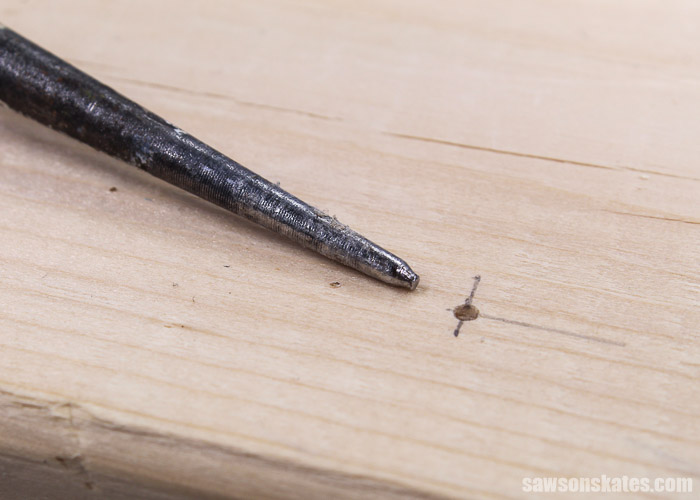
Do You Need an Awl?
You may not need an awl but it’s a good idea to have one. For me, an awl is “an ounce of prevention is worth a pound of cure” tool that you want in your workshop.
As I mentioned earlier, an awl creates a starting point which reduces the chances of tools wandering. If we don’t create a starting point for our tools, those tools can wander across the surface of the wood. And when tools wander, they cause damage to the wood.
This means the damage will need to be sanded out if we plan to stain the project. Or it will need to be filled with a filler to hide the damage if we plan to paint our project.
Related: 11 Secrets for Sanding Wood Projects Like a Pro
It takes only a few seconds to use an awl to make a starting point for a drill bit. Which is much less time than it would take to sand out any damage.
Back to Table of ContentsCan You Use a Hammer on a Scratch Awl?
Yes. It’s easy to use an awl to make holes in softwoods like pine. It’s more difficult to make holes in hardwoods like oak, mahogany, maple, etc.
For hardwoods, you can position the awl and give it a slight tap with a hammer.
Back to Table of ContentsWhere to Buy an Awl
Awls are available at home improvement stores, hardware stores, and online. Here are a few options you can buy online and have sent to your workshop.
Back to Table of ContentsWhat Can I Use Instead of an Awl?
In a pinch, you could use a nail or the point of a small Phillips screwdriver to make a hole.
Back to Table of ContentsHow to Use an Awl to Scribe Lines
Step 1. Mark the Location
Use a pencil to mark the location for the line.
Step 2. Scribe the Line
Place a straightedge across the marks and drag the awl to create a groove.
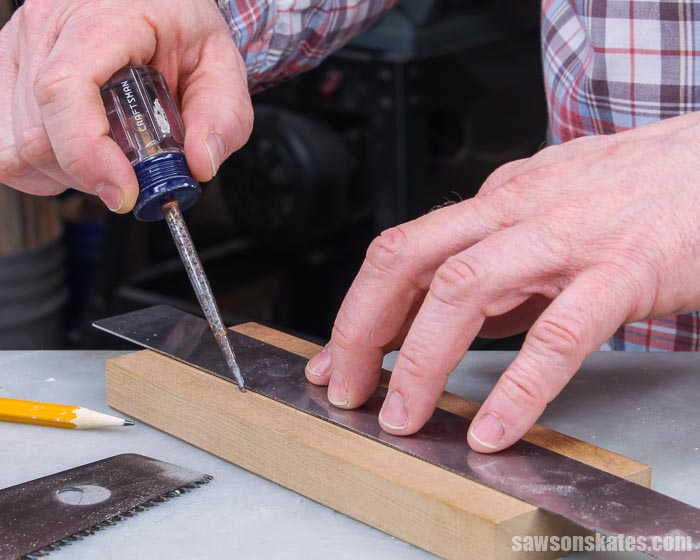
Step 3. Make the Cut
Position the hand saw or chisel in the groove and make the cut.
Back to Table of ContentsHow to Use an Awl to Make Holes
Step 1. Mark the Location
Use a pencil and Kreg Multi-Mark to mark the location for the hole.
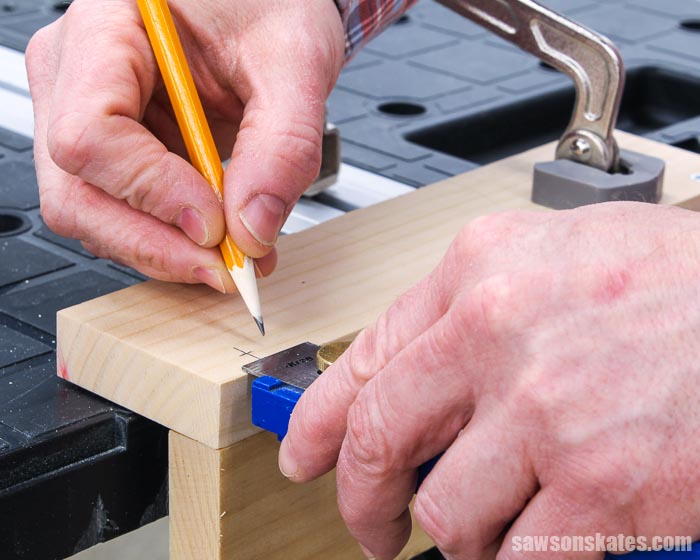
Step 2. Make a Starting Point
Push the awl into the wood to create a starting point.
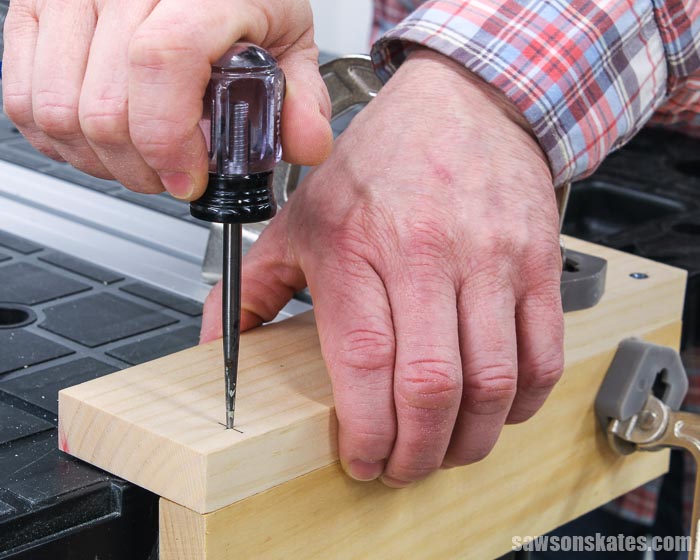
Step 3. Drill the Hole
Position the bit in the hole and drill.

Final Thoughts
An awl is basically a metal shaft with a sharp point. It’s used to create a starting point for another tool.
It can be used to scribe lines to create a starting point for a hand saw or chisel. Or it can be used to make holes to create a starting point for a screw or drill bit.
Thank you for stopping by. If you enjoyed this tutorial, would you please take a moment and pin it to Pinterest? I’d really appreciate it!

